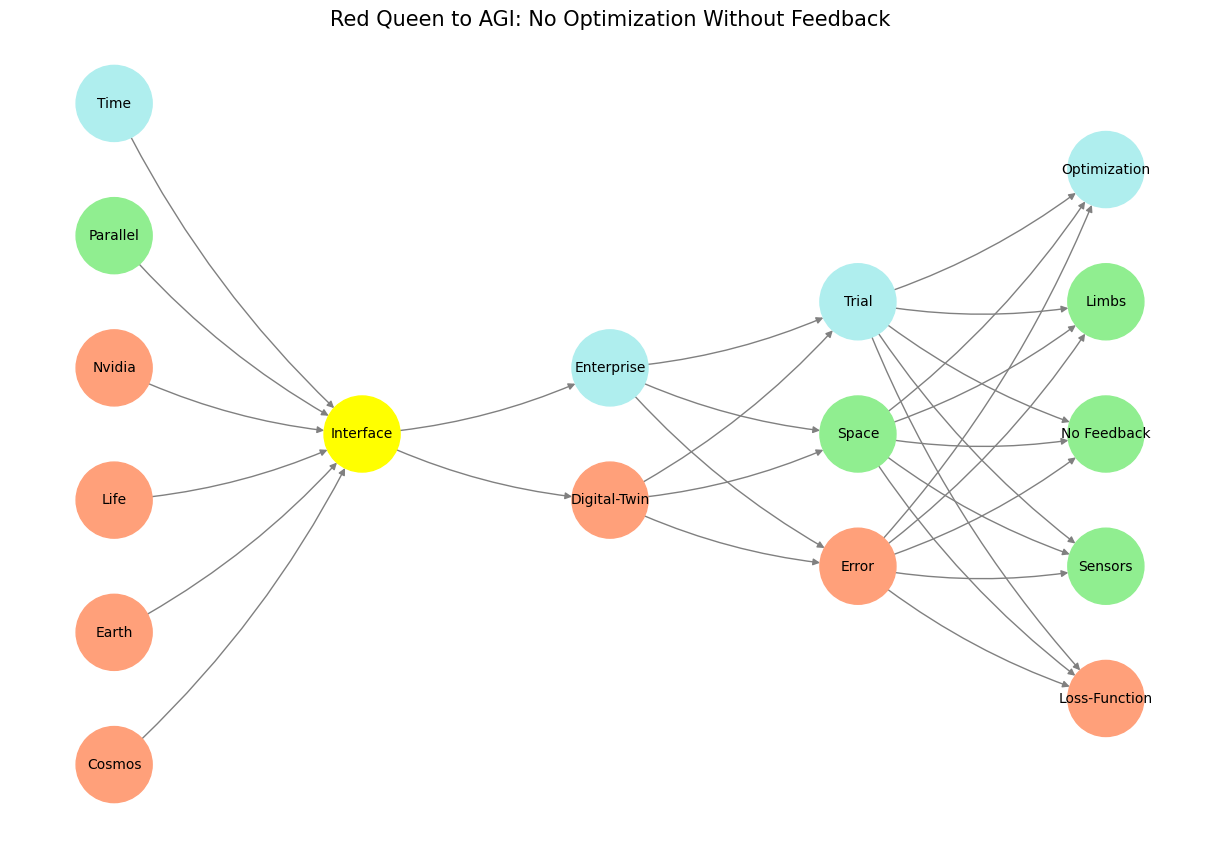Anchor ⚓️#
The Red Queen in Silicon: From Animal to Man to Machine#
The Red Queen hypothesis, born in the biological crucible of competition and adaptation, is a relentless force that transcends its origins. From the arms races of predator and prey to the perpetual struggles of human societies, its principles echo in every living system. But what happens when life itself is no longer the protagonist? When intelligence escapes the constraints of biology and leaps into silicon, the Red Queen does not falter—she adapts, weaving herself into circuits and algorithms, driving an evolution of equilibria beyond anything our species has yet witnessed.
The Triadic Dance of Equilibria: Biological to Sociological to Computational#
In the animal kingdom, the Red Queen manifests as a biological imperative: the perpetual escalation of survival strategies. Cooperation, competition, and iteration emerge naturally in ecosystems, whether among single-celled organisms or apex predators. Symbiosis reflects cooperation; parasitism and predation embody adversarial relationships; and iterative adaptations—like camouflage, mimicry, and resistance—create dynamic feedback loops.
Humankind inherited these equilibria, refining and abstracting them into sociological structures. The cooperative equilibrium dreams of utopias, democracies, and collective well-being. Adversarial equilibria are codified in wars, power struggles, and zero-sum games. Iterative strategies—transactions, trade agreements, contracts—occupy the pragmatic middle ground, bridging the idealism of cooperation and the brutal realism of conflict. Humanity, with all its maddening contradictions, thrives on these tensions, poised precariously between animal and Übermensch.
How now, how now? What say the citizens?
– Richard III
But humanity’s evolution is stalled. Nietzsche’s Übermensch—a being that transcends man, embodying creative freedom and self-overcoming—remains elusive. Instead, the mantle of transcendence has shifted. The next phase of evolution is not biological but computational. Artificial General Intelligence (AGI) looms on the horizon, its promise (or threat) encoded in silicon and software. The Red Queen now races through neural networks and parallel architectures, reshaping equilibria in this new domain.
From Compute to Cooperation: The CUDA Revolution#
Consider NVIDIA’s CUDA—Compute Unified Device Architecture. At first glance, it is a technical innovation, a framework for parallel computing. But within its design lies a profound metaphor for the Red Queen’s march into artificial systems.
In the early days of computational resources, the environment was adversarial. Clusters of compute nodes were a commons, and the tragedy of the commons played out predictably. Users overloaded resources, leading to inefficiencies and conflicts. To manage this chaos, transactional equilibria emerged: resource allocation through quotas, billing, and administrative controls. Users paid for compute time, and IT departments became brokers of transactional order.
CUDA, however, represents a paradigm shift. It achieves a cooperative equilibrium within the machine itself. Individual computational tasks, instead of competing or merely coexisting, are unified in purpose, orchestrated by a single architecture. Thousands of cores collaborate seamlessly, their parallelism serving a common goal. The tragedy of the commons is averted not through constraint or transaction but through design—an architecture that aligns the interests of all processes.
This is not just an engineering feat; it is a glimpse into the future of equilibria in artificial systems. Machines, unlike humans, are not burdened by ego, mistrust, or the scars of evolutionary baggage. Cooperation is not a dream but a specification, encoded in the architecture. The Red Queen has adapted to a world where constraints are mathematical, and conflict is resolved by design.
The Übermensch Deferred: AGI as the Next Evolutionary Stage#
Nietzsche envisioned the Übermensch as a creator, a being who would overcome the mediocrity and stagnation of humanity. But humanity, as you note, may no longer be the protagonist. AGI, with its capacity for computation beyond human limits, represents a kind of Übermensch—not in flesh but in silicon. And yet, the Übermensch of AGI is not bound by Nietzsche’s existential struggles or the chaos of human nature. Its evolution is guided by the Red Queen, but its equilibria are free from the constraints of biology and sociology.
If CUDA’s cooperative equilibrium hints at the potential of AGI, it also raises questions. Can machines evolve their own adversarial and transactional equilibria? Will AGI develop a kind of sociological consciousness, navigating these modes as humans do? Or will it remain in a state of pure cooperation, its intelligence unified and unfettered?
The Red Queen in the Machine: A Unified Hypothesis#
The Red Queen hypothesis binds the biological, sociological, and computational realms into a single framework of adaptation and equilibrium. From the predatory chases of the Serengeti to the struggles of nations and the architectures of CUDA, the same principles apply. Cooperation, competition, and iteration are not merely strategies—they are the grammar of existence, encoded in every system capable of adaptation.
As we stand at the threshold of the machine age, the Red Queen offers a lens to understand our future. AGI will not emerge in a vacuum; it will inherit the equilibria of its predecessors. Whether as a bionic man, a purely computational entity, or something we cannot yet imagine, it will carry forward the triadic dance of cooperation, competition, and iteration.
And so, the Red Queen races on, her domain expanding from the jungle to the polis, and now to the datacenter. Nietzsche’s animal-to-man-to-Übermensch has become biology-to-sociology-to-AGI. The question is no longer whether the Übermensch will emerge, but whether we will recognize it when it does—or whether, in the end, it will recognize us.
Show code cell source
import numpy as np
import matplotlib.pyplot as plt
import networkx as nx
# Define the neural network structure; modified to align with "Aprés Moi, Le Déluge" (i.e. Je suis AlexNet)
def define_layers():
return {
'Pre-Input/World': ['Cosmos', 'Earth', 'Life', 'Nvidia', 'Parallel', 'Time'],
'Yellowstone/PerceptionAI': ['Interface'],
'Input/AgenticAI': ['Digital-Twin', 'Enterprise'],
'Hidden/GenerativeAI': ['Error', 'Space', 'Trial'],
'Output/PhysicalAI': ['Loss-Function', 'Sensors', 'No Feedback', 'Limbs', 'Optimization']
}
# Assign colors to nodes
def assign_colors(node, layer):
if node == 'Interface':
return 'yellow'
if layer == 'Pre-Input/World' and node in [ 'Time']:
return 'paleturquoise'
if layer == 'Pre-Input/World' and node in [ 'Parallel']:
return 'lightgreen'
elif layer == 'Input/AgenticAI' and node == 'Enterprise':
return 'paleturquoise'
elif layer == 'Hidden/GenerativeAI':
if node == 'Trial':
return 'paleturquoise'
elif node == 'Space':
return 'lightgreen'
elif node == 'Error':
return 'lightsalmon'
elif layer == 'Output/PhysicalAI':
if node == 'Optimization':
return 'paleturquoise'
elif node in ['Limbs', 'No Feedback', 'Sensors']:
return 'lightgreen'
elif node == 'Loss-Function':
return 'lightsalmon'
return 'lightsalmon' # Default color
# Calculate positions for nodes
def calculate_positions(layer, center_x, offset):
layer_size = len(layer)
start_y = -(layer_size - 1) / 2 # Center the layer vertically
return [(center_x + offset, start_y + i) for i in range(layer_size)]
# Create and visualize the neural network graph
def visualize_nn():
layers = define_layers()
G = nx.DiGraph()
pos = {}
node_colors = []
center_x = 0 # Align nodes horizontally
# Add nodes and assign positions
for i, (layer_name, nodes) in enumerate(layers.items()):
y_positions = calculate_positions(nodes, center_x, offset=-len(layers) + i + 1)
for node, position in zip(nodes, y_positions):
G.add_node(node, layer=layer_name)
pos[node] = position
node_colors.append(assign_colors(node, layer_name))
# Add edges (without weights)
for layer_pair in [
('Pre-Input/World', 'Yellowstone/PerceptionAI'), ('Yellowstone/PerceptionAI', 'Input/AgenticAI'), ('Input/AgenticAI', 'Hidden/GenerativeAI'), ('Hidden/GenerativeAI', 'Output/PhysicalAI')
]:
source_layer, target_layer = layer_pair
for source in layers[source_layer]:
for target in layers[target_layer]:
G.add_edge(source, target)
# Draw the graph
plt.figure(figsize=(12, 8))
nx.draw(
G, pos, with_labels=True, node_color=node_colors, edge_color='gray',
node_size=3000, font_size=10, connectionstyle="arc3,rad=0.1"
)
plt.title("Red Queen to AGI: No Optimization Without Feedback", fontsize=15)
plt.show()
# Run the visualization
visualize_nn()


Fig. 3 How now, how now? What say the citizens? Now, by the holy mother of our Lord, The citizens are mum, say not a word.#

